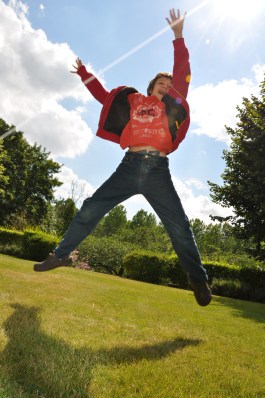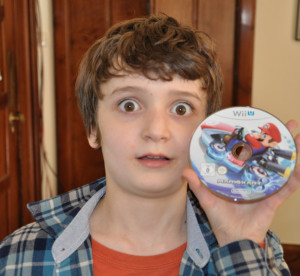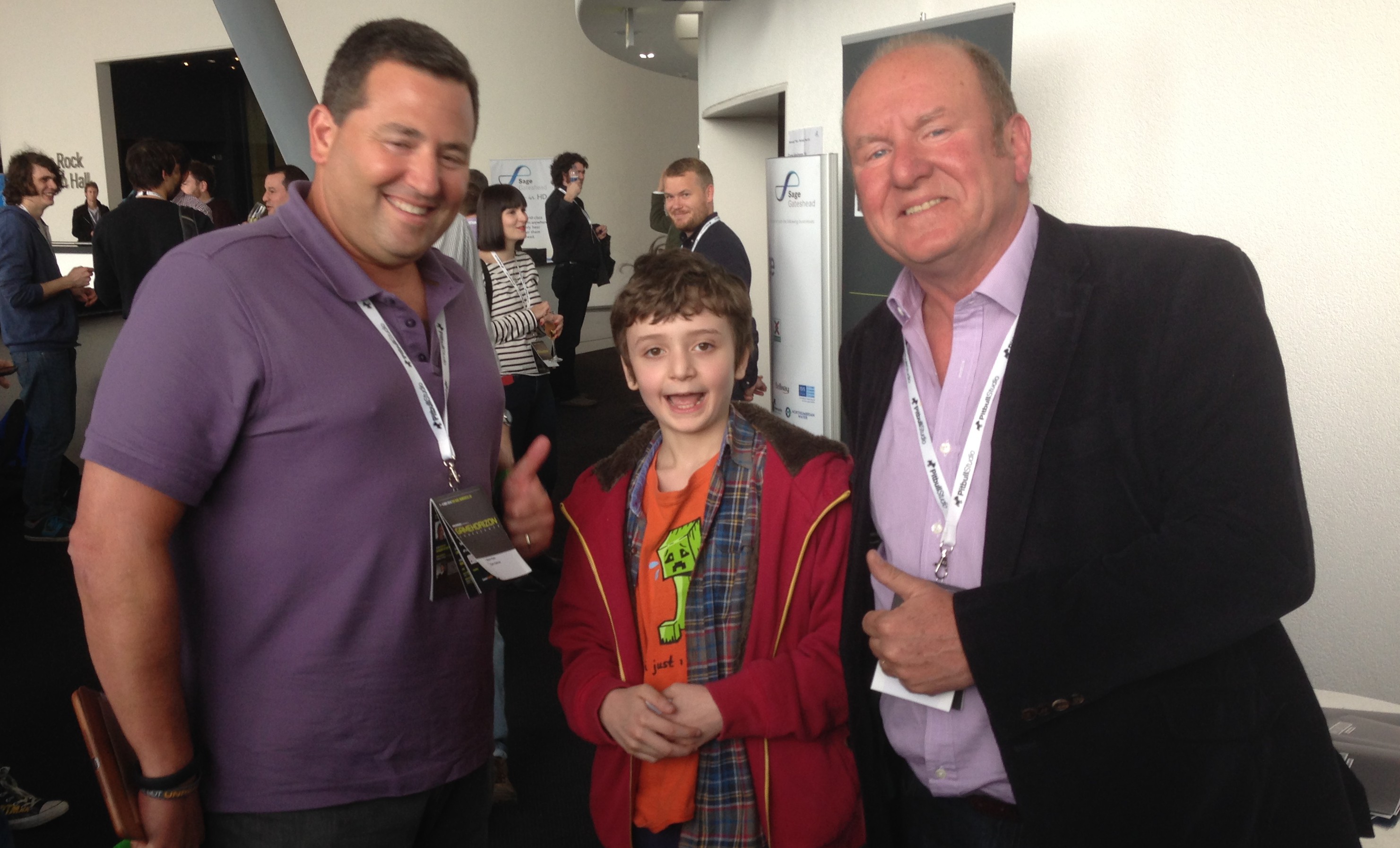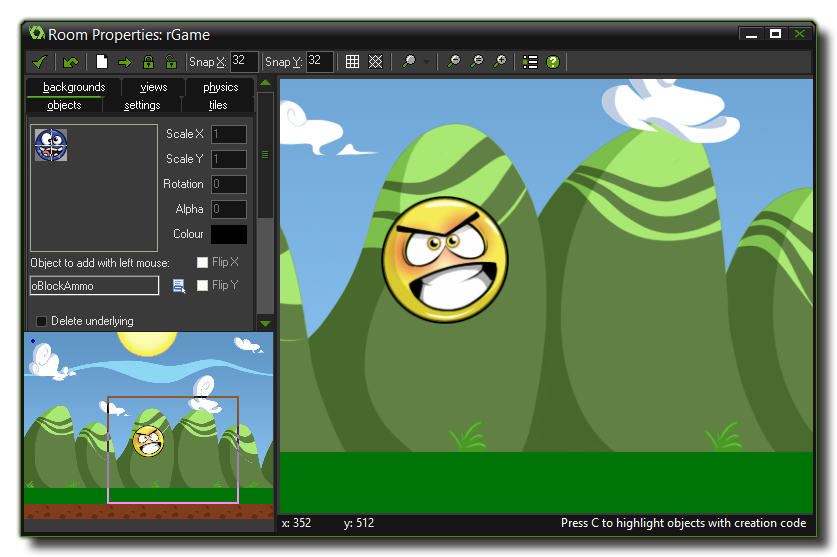Sam Smith is a 12-year-old game developer. That’s rather young, sure, but that’s not even the strangest part.
Sam makes games instead of going to school.
Spacepants is Sam’s latest game, available for $1 on iOS and Android devices. It’s a brutally tough “endless runner” — like Jetpack Joyride or Flappy Bird — set in a single room, which sees you avoiding lasers, space caterpillars, and other nasties for as long as you can while constantly moving.
My Spacepants record was 75.73 seconds when I spoke to Sam last week — although I’ve beaten it since — and he seemed reasonably impressed with my efforts. “It’s above average,” he told me enthusiastically, before sharing some background on his journey into game development.
Making Spacepants
Sam has been making games from his home in the south of England for “about a year.” He started out playing around with a programming language called Small Basic, a simplified version of Visual Basic, mostly making text-based adventures that are all words and no graphics.
It was Sam’s dad who introduced him to GameMaker: Studio, the creative resource suitable for programming novices that Sam used to build Spacepants. “He’s a programmer himself,” Sam told me. “He actually introduced me to how to make a game and how to read the [Game Maker] manual.”
As with many great ideas, Spacepants started out with a simple concept. “I wanted to make a game where you could walk up walls because walking up walls is fun,” said Sam.
He began with a free program called Aseprite to design the art and animations for the main character, Spacepants guy, and the space caterpillar that’s his enemy. After that, he tested various controls schemes, finally nailing the beautifully simple two-button method that made the final game. Then came a lot of tweaking of movement speed and jumping heights and the addition of other enemies, all while using GameMaker: Studio “for the coding and making the things work.”
In total, it took Sam two months to create and test the game — with a little help from his dad when he got stuck — and he’s continuing to support it with updates based on feedback.
Game design lecturer Sean Oxspring recently called Spacepants “The Dark Souls of infinite runners,” referencing the brutally tough action role-playing game from publisher Bandai Namco. But this wasn’t an intentional part of the design. “I wasn’t trying to make it hard when I made it,” Sam told me. He did admit, however, to taking some inspiration from Super Hexagon, the notoriously tricky twitch-action game by Irish developer Terry Cavanagh.
A gaming education
Sam’s family took him out of school about three years ago. It was a tough call to make, but they decided it was their only option.
Unlike his two brothers, Sam had really been struggling with school life. He explained that he’d had difficulty keeping attention and found school “very difficult to cope with.”
“I fell asleep in class at points,” said Sam. “Eventually, I just started hiding under the table a lot of the time.”
Taking Sam out of school wasn’t difficult in terms of paperwork and bureaucracy. All it took was was for the Smith family to complete a single-sheet form, assuring the authorities that they would look after Sam and give him an education.
What was difficult was adjusting family life to make sure that Sam had someone to look after and educate him.
In the U.K., where home education is still relatively rare, home-schooled children have no set curriculum to follow; parents just need to provide an education suitable for their child’s age, ability, and aptitude. And while most local education authorities in the U.K. make contact with parents of home-schooled children once a year, they have no statutory requirement to do so.
At first, Sam had a range of people to keep him learning at home. “I had a tutor come round to teach me art for a while,” he told me. “I was also taught geography by my mum, science by my [grandma], and math by my grandad.”
Fast-forward three years, and Sam is now predominantly learning by making games. “I pretty much learn things every day by being around my family and being around other people and with the Internet,” he told me. “But I am spending a lot of my time figuring out things and making games. You learn things through that as well.”
I asked Sam’s dad, who was in the background during our chat, if he was confident that crafting games would give Sam the education he needs. He joked that we’d find out, adding that games are, in his opinion, the best learning tools for humans. He pointed me to recent comments by entrepreneur and Eidos life president Ian Livingstone, who says that playing and making games are great ways for children to learn and that schools should change the way they work to reflect this.
Success
Sam had a small goal when he released Spacepants on iOS back in May. “I’m too young to have a job,” he told me, “so I thought I’d see if I can get £5.”
He’s now smashed that goal, making enough money to buy his younger brother a PlayStation 4 and giving his older brother a gaming fund to spend how he wants. As for Sam, he bought Mario Kart 8 for the Wii U “so I could shoot red shells at my brothers.”
The level of recognition that Spacepants has got has clearly blown Sam away. “It’s quite amazing to think how many people have discovered SpacePants,” he told me. “According to the leaderboards, there are over 1,000 people playing,” he added. “Even my score has been beaten!”
And, looking at the leaderboards, who is better at it — Android or iOS players? “Android players, it would seem,” he said.
The perils of free-to-play
The mobile market is increasingly dominated by free-to-play games. Finnish developer Supercell generated $892 million in revenue during 2013 from just two free-to-play titles — Clash of Clans and Hay Day. Income from microtransactions and advertising can combine to turn supposedly free apps into cash cows, but the free-to-play model has its critics, including Sam.
I asked why he’d chosen to make Spacepants a paid-for product and not a free-to-download game.
“If a game is free,” he told me, “then you’ll probably have adverts and in-app purchases. I wanted, if someone buys a game, they get the game, and they don’t need to just pay for more and more and more. It’s not fun. I wanted to do that while being able to earn some money from it.”
So, what’s wrong with in-app purchases?
“It’s just trying to grab people’s money,” said Sam, “and just luring them in by pretending to be free. Then you have to spend money for the next billion levels. I’d much rather have it be simple.”
He does approve of some free-to-play, though, such as Blizzard’s Hearthstone: Heroes of Warcraft collectible-card game. “It doesn’t steal your money because everything there you can earn without paying money,” he said.
Opening up communication
I asked Sam if there was anything he missed about attending school. “It was originally the fact that there aren’t many people at home,” he said.
But he pointed out that as he’s become more involved in making games, he’s met new people and “it’s become more and more interesting and fun.”
Sam recently discovered Twitter, and it’s been a revelation for him, opening up a direct line of communication with fellow game developers. He explained the appeal of Twitter as “being able to have people who know what I do and like what I do, and then know what they do and like what they do.”
As well as meeting and chatting to fellow developers on Twitter, Sam has attended events like Insomnia, the U.K.’s biggest gaming festival, and he’s met Thomas Was Alone creator Mike Bithell in person, the two of them chatting about “some fun ideas for games.”
Sam also recently helped deliver a presentation on childhood, learning, nostalgia and creativity at the Game Horizon conference in Newcastle, U.K., reducing at least one game journalist to tears.
Advice for other young developers
Interestingly, Sam pointed out that he’s spent a lot of time playing games like Minecraft, Kerbal Space Program, and Garry’s Mod — “anything that’s kind of sandboxy really” — and these helped him feel a bit like a developer before he starting making his own games.
When it comes to actually developing, though, he thinks GameMaker: Studio is the best place to start. “If you want to make a game, you probably want to start there really,” he said. “That’s what I did.”
I asked if that was a gentle enough introduction to making games for everyone, thinking of other platforms like Scratch, but Sam was adamant that GameMaker: Studio is a good first step. “I think everything else is pretty boring really,” he said. It also helps that GameMaker: Studio is free, at least until you want to export your game to mobile devices.
I reached out the YoYo Games, the creators of GameMaker: Studio, to ask their thoughts on Sam’s unusual path into game development.
“One of the ideas behind the development of GameMaker: Studio was to provide aspiring game makers with the opportunity to dive in and get to creating games without any prior design or programming experience,” said Russell Kay, chief technology officer at YoYo Games. “We love to see young developers and students like Sam introduced to game development through GameMaker. There are many critical skills that can be learned while having fun creating something like Spacepants that can then be enjoyed by family and friends and, potentially, by millions of others.”
The pixel-art style of a lot of current indie games has certainly helped Sam to feel like being a game developer is something attainable.
He did originally wanted to use Unity to create a 3D game, but his dad convinced him to stick with 2D for the time being, given the strength of his pixel-art skills. “Unity is a lot more complicated and lot less fun,” said Sam, adding that going down the 3D route might produce more professional looking games but just gets “harder and harder and harder.”
I spent some time chatting with Sam’s dad at the end of our interview, musing on the state of computing education in schools. I pointed out that my own children had found the teaching of programming, now a mandatory part of the U.K.’s school curriculum for 5-14 year olds, rather dull. The prescriptive and limited nature of the tasks they had to undertake, in a regimented order, was particularly off-putting.
Sam’s solution? “They should just sit people down at the computer and leave the room.” Which doesn’t sound like a bad idea at all.
The future
Sam is sure that he’ll be making games for a long time to come. “I want to continue making games for most of my life,” he told me. He didn’t, however, rule out the chance that he may return to school sometime in the future, depending on how things go.
For now, though, Sam seems perfectly in his element. You can hear that in his voice, which comes alive when he’s describing the development process and sharing his gaming experiences.
After the success of Spacepants, Sam’s next game is already in the design phase. “It’s going to be a game where you play as a robot,” he told me. “There are other things, but there’s only one robot.”
I can’t wait to see how it turns out.
VentureBeat's mission is to be a digital town square for technical decision-makers to gain knowledge about transformative enterprise technology and transact. Learn More






